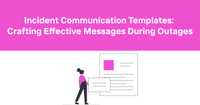Incident Communication Strategies: Crisis Management and Customer Relations
Your servers are on fire. Your website is down. Your mobile app is throwing errors. And your customers are flooding social media with angry complaints about your broken service. In moments like these, what you say and how you say it can determine whether you emerge from the crisis with stronger customer relationships or permanent damage to your reputation.
Most companies handle incident communication terribly. They stay silent hoping the problem will fix itself quickly. They post vague updates that tell customers nothing useful. They blame external vendors or act like the outage isn't really their fault. These approaches turn technical problems into PR disasters that outlast the original incident.
Smart companies treat incident communication as seriously as incident resolution. They know that how they communicate during crises defines their brand more powerfully than any marketing campaign. They build trust through transparency, demonstrate competence through clear updates, and turn potentially destructive incidents into demonstrations of their commitment to customer success.
The Psychology of Crisis Communication
During outages, your customers experience a range of emotions that evolve as the incident progresses. Understanding this emotional journey helps you craft communication strategies that address what customers actually need, not just what you think they want to hear.
Initial customer reactions typically include confusion and frustration. Users assume they're doing something wrong or their internet connection is broken. They refresh pages repeatedly, restart apps, and waste time troubleshooting problems they can't fix.
As users realize the problem is on your end, confusion transforms into anger. They feel helpless and frustrated that your technical problems are preventing them from accomplishing their goals. This anger intensifies when they can't find any acknowledgment that you're aware of the problem.
The anger phase is where most companies lose customers permanently. Users interpret silence as indifference. They assume you don't care about their experience or aren't competent enough to recognize your own problems. Social media amplifies these perceptions as frustrated customers share their negative experiences publicly.
Trust Through Transparency
Transparent communication during incidents builds trust even when you can't immediately fix the underlying problem. Customers can forgive technical failures, but they rarely forgive feeling ignored or misled during those failures.
Acknowledge problems quickly and honestly. Don't wait until you have a complete solution before communicating. Early acknowledgment shows customers that you're aware of their experience and working to improve it.
Provide specific information about what's affected and what isn't. Customers need to know whether they should wait for your service to recover or find alternative solutions. Vague statements like "we're experiencing technical difficulties" don't help anyone make informed decisions.
Admit when you don't know something rather than speculating or providing false reassurance. Saying "we're still investigating the cause" is better than promising a fix in 30 minutes when you have no idea how long resolution will take.
Managing Customer Expectations
Setting realistic expectations during incidents prevents the disappointment and additional anger that comes from missed deadlines and broken promises. Customers prefer honest uncertainty to false confidence that gets shattered repeatedly.
Provide time estimates only when you have reasonable confidence in them. It's better to give broader timeframes that you can beat than specific deadlines that you'll miss. "We expect to have this resolved within the next 2 hours" is better than "we'll fix this in 20 minutes" when you're not sure.
Explain the complexity of the problem in terms customers can understand. Help them appreciate why certain fixes take time without overwhelming them with technical details they don't need.
Update estimates as you learn more, and explain why timelines changed. Customers understand that complex problems sometimes take longer than expected, but they need to understand why your estimates evolved.
Building Effective Communication Frameworks
Successful incident communication requires preparation before incidents happen. You can't develop communication strategies, identify stakeholders, and establish approval processes while your servers are melting down.
Stakeholder Identification and Responsibility
Different stakeholders need different types of information during incidents. Customers want to know how problems affect them and when resolution is expected. Internal teams need technical details and coordination information. Executives need business impact summaries and external communication oversight.
Define clear roles for incident communication before incidents occur. Who has authority to post public updates? Who approves external communications? Who manages social media responses? These decisions take too long during actual incidents when every minute counts.
Establish escalation procedures for communication decisions. Minor incidents might only require automated status page updates. Major incidents affecting thousands of customers need coordinated communication across multiple channels with executive involvement.
Create communication templates for common incident types. Having pre-written framework messages reduces the time needed to craft updates and ensures consistent tone and information quality across different incidents.
Multi-Channel Communication Strategy
Your customers use different communication channels and have different preferences for receiving updates. Comprehensive incident communication reaches customers where they are, not just where it's convenient for you to communicate.
Status pages serve as the authoritative source for incident information. They should be the first place customers look for updates and the most detailed source of information about ongoing problems. Status pages need to work even when your main services are down.
Social media provides immediate reach to customers who might not know to check your status page. Twitter, Facebook, LinkedIn, and other platforms help you proactively communicate with customers who might otherwise assume your silence means you're unaware of problems.
Email notifications reach customers directly but can feel impersonal during incidents. Use email for incident communications that require more detail than social media allows or for communicating with specific customer segments affected by particular problems.
In-app notifications work well for mobile applications and web services where you can display messages directly to affected users. These notifications should link to more detailed information on status pages or help documentation.
Message Consistency and Tone
Inconsistent messaging across different channels confuses customers and undermines confidence in your incident response capabilities. Develop messaging frameworks that ensure consistency while allowing channel-specific adaptations.
Establish a clear, professional tone that matches your brand personality while acknowledging the seriousness of customer impact. Avoid overly casual language that might seem dismissive, but also avoid corporate speak that sounds robotic and uncaring.
Focus on customer impact rather than technical details in most communications. Customers care about what they can't do and when they'll be able to do it again. Technical implementation details matter less than business functionality restoration.
Take responsibility without making legal admissions that could create liability issues. You can acknowledge that your service isn't working properly without admitting negligence or accepting blame for downstream consequences of the outage.
Real-Time Communication During Active Incidents
When incidents are actively occurring, communication becomes a balance between providing timely updates and ensuring accuracy. Customers want frequent updates, but rushed communications often contain errors that create additional problems.
Incident Lifecycle Communication
Different phases of incident response require different communication approaches. Initial acknowledgment focuses on confirming that you're aware of the problem and working on it. Investigation updates explain what you've learned and what you're testing. Resolution communication confirms that problems are fixed and outlines steps you're taking to prevent recurrence.
First acknowledgment should happen within 15 minutes of becoming aware of significant incidents affecting customer-facing services. This initial communication doesn't need to explain causes or provide solutions - it just needs to acknowledge that you're aware of the problem and taking it seriously.
Regular updates during ongoing incidents help customers understand that you're actively working on resolution. Update frequency depends on incident severity and duration. Major incidents affecting many customers might warrant updates every 30 minutes. Minor incidents might only need updates every few hours.
Resolution communication should confirm that the problem is fixed and explain any steps customers need to take. Sometimes resolution requires customer action like clearing caches, logging out and back in, or updating mobile applications.
Balancing Speed and Accuracy
Fast communication builds customer confidence, but inaccurate communication destroys it. Develop processes that enable rapid response while maintaining information quality standards.
Establish approval workflows that match incident severity. Minor incidents might allow frontline support staff to post updates directly. Major incidents might require management approval for all external communications.
Use staged communication approaches where initial acknowledgment can happen quickly while more detailed updates wait for additional investigation. Customers prefer knowing you're aware of problems even if you don't yet understand causes or solutions.
Build templates for common update types to speed communication without sacrificing accuracy. Templates provide structure while allowing customization for specific incident details.
Handling Escalating Customer Emotions
Customer frustration often intensifies during prolonged incidents, especially if communication is infrequent or unhelpful. Develop strategies for managing escalating emotions without compromising technical resolution efforts.
Acknowledge customer frustration explicitly in your communications. Phrases like "we understand how frustrating this must be" show empathy without making promises you might not be able to keep.
Provide alternative solutions when possible. If your main website is down but your mobile app works, tell customers. If certain features are unavailable but others work normally, explain what customers can still accomplish.
Resist the temptation to be defensive when customers express anger about your service problems. Focus on resolution and improvement rather than justifying why problems occurred or defending your technical architecture choices.
Post-Incident Communication and Learning
How you communicate after incidents are resolved often matters more for long-term customer relationships than how you communicated during the incidents themselves. Post-incident communication demonstrates your commitment to improvement and learning from failures.
Comprehensive Incident Postmortems
Public postmortems show customers that you take incidents seriously and are committed to preventing similar problems in the future. Not every incident needs a public postmortem, but significant outages that affected many customers deserve transparent follow-up communication.
Explain what happened in terms that non-technical customers can understand. Focus on business impact and user experience rather than technical implementation details. Help customers understand why the incident occurred without overwhelming them with technical minutiae.
Describe specific steps you're taking to prevent similar incidents. These might include infrastructure improvements, process changes, monitoring enhancements, or team training initiatives. Customers want to know that you're learning from failures and investing in better reliability.
Provide realistic timelines for implementing improvements. Some fixes can happen immediately, while others might require months of engineering work. Help customers understand your improvement roadmap without making promises you can't keep.
Rebuilding Customer Confidence
Incidents damage customer confidence even when they're resolved quickly and communicated well. Rebuilding that confidence requires consistent demonstration of improved reliability and continued commitment to customer success.
Follow through on commitments made during incident communication. If you promised infrastructure improvements or process changes, provide updates on your progress implementing those changes.
Share reliability metrics and improvement trends when appropriate. Customers who experienced significant outages want evidence that you're actually becoming more reliable, not just saying you are.
Consider providing service credits or other compensation for significant incidents, even when not required by service level agreements. This demonstrates that you value customer relationships and understand the business impact of service problems.
Communication Tools and Infrastructure
Effective incident communication requires tools and infrastructure that remain available even when your primary services are experiencing problems.
Status Page Management
Status pages need to be hosted independently from your main infrastructure to ensure they remain available during incidents that affect your primary systems. Use dedicated status page services or host status pages on separate infrastructure from your main applications.
Design status pages that provide useful information without requiring frequent manual updates. Integration with monitoring systems can automatically update component status based on health checks and alerting data.
Include historical incident information on status pages to provide context for current problems and demonstrate your track record of resolution. Customers often want to know whether current problems are recurring issues or isolated incidents.
Automated Communication Systems
Automation helps ensure consistent, timely communication during incidents while reducing the workload on incident response teams who need to focus on technical resolution.
Integrate communication tools with monitoring and alerting systems to enable automatic status updates when incidents are detected. This ensures that customer-facing communications happen even if human responders are delayed.
Use automation for routine communication tasks like acknowledgment messages and resolution confirmations. Reserve human involvement for complex communications that require judgment, empathy, or detailed explanations.
Build escalation procedures that automatically involve additional team members if incidents aren't acknowledged or updated within defined timeframes. This prevents communication gaps when primary responders are unavailable.
Effective incident communication transforms potential reputation disasters into demonstrations of competence, transparency, and customer commitment. Companies that communicate well during crises often emerge with stronger customer relationships than they had before the incidents occurred.
The investment in incident communication preparation pays dividends in customer retention, brand reputation, and team confidence during actual incidents. When problems inevitably occur, your response defines your company more than the problems themselves.
Ready to handle incident communication professionally? Odown provides integrated status pages and incident management that streamline customer communication during outages. Combined with our Core Web Vitals optimization guide and certificate management strategies, you'll have the tools and knowledge to maintain both technical reliability and customer trust when incidents occur.



